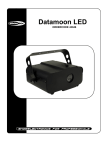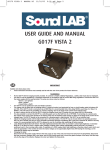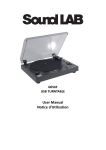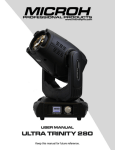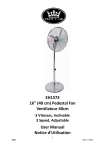Download MK Sound MX-80 User guide
Transcript
IQ-MX80 Features of the IQ-MX80 • Controls up to 16 NJD intelligent lighting products independently. • Controls: Predator MX and HX, Chroma HX and Chroma 50, Microbeam 100, IQ250 (Mk.1, 2 & 3) , IQ500 (Mk.1 & 2), Datamoon, Spectre, Raptor, Quasar, and SB500 Super Blitzer • Joystick for manual operation or programming • Touch pad control of colour and gobo. • Ten built in programs • Ten user-writable programs of 250 steps • Real-time programming • Strobe facility • Lamp on/off facility (halogen lamps only) User Guide IQ-MX80 IMPORTANT Installer and Users please note: These instructions should be read carefully and left with the user of the product for future reference. Installation. Connect the IQ-MX80 to the 230V mains supply with the lead supplied. • Brown = live • Blue = neutral • Green/Yellow = earth • The IQ-MX80 must be earthed to ensure safety and correct operation of the touch pads. If sound activated operation is required, connect a sound signal, either 0dBm from the line-level output of a mixer, or the speaker output from an amplifier, to the sound input jack. Great care should be taken not to connect the sound input to the DMX-output socket, as this may destroy the internal electronics (the DMX line-driver) Connect the DMX output from the IQ-MX80 to the DMX input of the nearest lantern. The DMX output socket is a 3-pin XLR. Pin connections are as follows: Pin 1 = ground connect to sleeve on stereo ¼" jack Pin 2 = Data + Pin 3 = Data − or Pin 1 on 5-pin XLR connect to tip on stereo ¼" jack or Pin 3 on 5-pin XLR connect to ring on stereo ¼" jack or Pin 2 on 5-pin XLR On a 3-pin XLR, Pin 3 is the one in the middle. Refer to the “externally controlled” section of the lantern user guide for further information on connection. Portable Appliance Testing The IQ-MX80 should be checked for Electrical Safety annually, and if it is hire equipment, before it is hired out. A high-voltage test (at 500V or 1000V) should be carried out between live and earth, and an earth bonding test between the case and the earth connection (at 6A or 10A). Insulation resistance should be greater than 10MW and earth bonding resistance less than 0.5W. A high voltage test may also be carried out between the © N.J.D. Electronics 1997 -Page 2- User Guide IQ-MX80 DMX and audio inputs and live, if the equipment has passed the live-earth test. Do not test high-voltage or earth bonding between DMX or audio inputs and earth - this will destroy the electronics. Setting the DMX address switches. The DMX switches on the lantern should be set as shown. If your lantern has a 3-digit LED display, set the display to the number in the "DMX start address" column, and set the operating mode to "F 1" or "F 3" (F 3 reverses the left-right joystick movement. This allows the joystick to work in the most logical fashion, depending on whether the lanterns are facing towards or away from the controller). If it has DIL switches, refer to the "switches ON" column. If there are also switches labelled "MODE" (e.g. Spectre) set them to the "IQ-MX80" setting Note: The switch numbers refer to the numbers printed on the product label adjacent to the switch, not to the numbers on the switch itself. Lantern number DMX Switches ON start address (other switches off) 1 1 None 2 9 8 3 17 16 4 25 16, 8 5 33 32 6 41 32, 8 7 49 32, 16 8 57 32, 16, 8 9 65 64 10 73 64, 8 11 81 64, 16 12 89 64, 16, 8 13 97 64, 32 . . .continued overleaf © N.J.D. Electronics 1997 -Page 3- User Guide IQ-MX80 Lantern number DMX Switches ON start address (other switches off) 14 105 64, 32, 8 15 113 64, 32, 16 16 121 64, 32, 16, 8 1 (reversed in X direction) 5 4 2 (reversed in X direction) 13 8, 4 3 (reversed in X direction) 21 16, 4 4 (reversed in X direction) 29 16, 8, 4 5 (reversed in X direction) 37 32, 4 6 (reversed in X direction) 45 32, 8, 4 7 (reversed in X direction) 53 32, 16, 4 8 (reversed in X direction) 61 32, 16, 8, 4 9 (reversed in X direction) 69 64, 4 10 (reversed in X direction) 77 64, 8, 4 11 (reversed in X direction) 85 64, 16, 4 12 (reversed in X direction) 93 64, 16, 8, 4 13 (reversed in X direction) 101 64, 32, 4 14 (reversed in X direction) 109 64, 32, 8, 4 15 (reversed in X direction) 117 64, 32, 16, 4 16 (reversed in X direction) 125 64, 32, 16, 8, 4 If the lantern has switches labelled "1", "2" or "128", set these to OFF. Switch 4 reverses the X-direction movement. This allows the joystick to work in the most logical fashion, depending on whether the lanterns are facing towards or away from the controller. Predators and later IQ250/IQ500 have an extra xreverse switch. For these lanterns set the "4" switch to OFF. The IQ-MX80 only outputs the first 128 DMX channels. A lantern with its DMX address set to a number greater than 128 will not function. Up to 32 lanterns may be connected to the IQ-MX80. Lanterns assigned to the same channel will perform identically. The total length of DMX cable run should not exceed 250m © N.J.D. Electronics 1997 -Page 4- User Guide IQ-MX80 Operation. When the IQ-MX80 is first turned on from new, it will start in Manual mode, the display will show - - - - - and the manual LED will be lit. On subsequent occasions, when the IQ-MX80 is switched on, it will resume operation from where it was switched off, allowing it to be turned on and off remotely and operate automatically in situations where an operator is not available. Manual Mode In manual mode, the user has direct control over any number of the lanterns with the colour and gobo touch pads and the joystick. First select the colour and gobo required. To select split colours, touch two adjacent pads: i.e. to select red/green split, touch red and green together. To select colour scrolling, set the scrolling speed on the speed control and then touch magenta and white together. Then select the lanterns required by touching the lantern select pads. The selected colour and gobo will then be assigned to the selected lanterns. The joystick will then control the movement of the selected lanterns. The colour and gobo must be selected first. This allows several cans to be controlled simultaneously by the joystick, but with different colours and gobos. Whenever a lantern is selected it takes the colour and gobo selected on the colour/gobo keypad. The joystick controls the movement of all selected lanterns. To change the colour and gobo, change the colour and gobo, deselect the lantern by touching the lantern select pad, and then re-select the lantern. When a lantern is de-selected, it remains in the last position set on the joystick. This allows all lanterns to be positioned individually. To select strobe touch blackout and l together. If selecting strobe on the Microbeam, Datamoon or IQ250, first select white; otherwise these products will attempt to strobe in other colours and will not be too successful. The Predators, Chroma HX and IQ500 can strobe in any colour. In manual mode, the blackout pad turns the lamp off on © N.J.D. Electronics 1997 -Page 5- User Guide IQ-MX80 products with halogen lamps; on products with Metal Halide lamps, the lamp continues to run and is blacked out by a shutter. Short-cut: to change the colour and gobo of all selected lanterns, select the new colour and gobo and touch the run pad. Use with various lanterns • Predator HX/MX all features are available • IQ500 Split colours and colour scrolling are not available • Microbeam, IQ250 Gobo pads have no effect (except for blackout and strobe) • Datamoon. Joystick x-axis controls dish rotation, y-axis has no effect. Split colours and colour scrolling are not available. Gobo pads have no effect (except for blackout and strobe) • Chroma HX / Chroma 50 Joystick x-axis has no effect, y-axis controls dimming. Some split colours and colour scrolling are available, but gobo pads have no effect (except blackout and strobe) The IQ-MX80 is not compatible with the Chroma 250. • Raptor Joystick x-axis controls barrel rotation, y-axis controls barrel left-right movement. Split colours are available. • Quasar Joystick x-axis controls dish rotation, y-axis controls dish leftright movement. Split colours are available. • SB500 Super Blitzer Joystick x-axis controls dish rotation, y-axis controls dimming. Colours and gobos have no effect (except blackout and strobe) Running programs. Switch off manual mode by touching the MAN. pad. The display will now show the program number and the step number in the program. Select the program number by touching the PROG pad. Programs 1 to 10 are factory written programs and cannot be overwritten. Programs 11 to 20 are user-writable programs, and can be overwritten at any time if the write enable © N.J.D. Electronics 1997 -Page 6- User Guide IQ-MX80 switch on the rear panel is in the "enable" position. A battery inside the IQ-MX80 retains the user programs when the mains power is disconnected, provided that the IQ-MX80 is used at least once every 3 months. Select the animation mode by touching the SOUND pad. Green =sound animated No led lit = variable speed animation - the speed is set on the speed control Red = stop/single step operation. The lanterns will remain static, and will advance one step when the STEP pad is touched. When the IQ-MX80 reaches the end of the program it starts again at the beginning. To run through all programs sequentially, select run mode by touching the RUN pad. The run led will light. The IQ-MX80 will run through each program four times and then change to the next. To return to manual mode, touch the MAN. pad. The IQMX80 will return to the lanterns and the colours that were selected when manual mode was exited. Short-cut: To change programs quickly, touch the PROG pad and touch the lantern select pad that corresponds to the number of the program required before releasing the PROG pad. Only programs 1 to 16 are available by this method. Manual Override: Whilst running programs, the lantern select and colour/gobo pads can be used as in manual mode, to override the program. The only difference is the scroll speed which is fixed. When the lantern is de-selected it resumes running the program. To remove certain lanterns from a program, select BLACKOUT and select the lanterns to be removed. Writing programs. Programs 11 to 20 can be written by the user. The write enable/disable switch on the rear panel must be in the enable position. Select write by touching the WRITE pad, the write LED will flash. Select the required program by touching the prog pad, until © N.J.D. Electronics 1997 -Page 7- User Guide IQ-MX80 the required program number appears in the display. Set up the required colours, gobos and beam positions on the lanterns for the first step of the program and touch ENTER. The letter E appears in the step display to acknowledge that enter has been touched. Touch STEP to advance to the next step in the program. The lanterns will then display the settings previously stored in the new step. To view the current settings of the joystick and colour/gobo pads, touch RUN. Repeat for the other steps in the program, up to a maximum of 250 steps. If programming fewer then 250 steps; after the last step, Select lantern #1, touch STEP to advance to the next step, and then touch END. The letter E appears in the program display to acknowledge that end has been programmed. It is most effective to program each lantern in turn. When programming, lanterns that are not selected will display the colours and positions that have already been programmed into them. Touch the WRITE pad again to exit from program-write mode. Switch the write disable switch back into the disable position to protect the programs that had been written. When writing or running programs, the BLACKOUT pad operates the shutter leaving the lamp on. Real time programming. The write enable/disable switch on the rear panel must be in the enable position. Select write by touching the WRITE pad, the write LED will flash. Select the required program by touching the PROG pad, until the required program number appears in the display. If the program is not to involve all 16 lanterns, first clear the program as follows: Select BLACKOUT and all 16 lanterns. Set the joystick to the centre. Then touch START and wait until the display counts to 250. Set the colours and gobos and select the lanterns required. Move the beams to the starting position using the joystick. When ready, touch the START pad. The IQ-MX80 will record the joystick position ten times per second, making a program of 250 © N.J.D. Electronics 1997 -Page 8- User Guide IQ-MX80 steps which is 25 seconds long. If the program needs to be shorter, touch the END pad. To change colours and gobos, select the new combination, deselect then reselect the lantern by pressing the lantern select pad twice; or, to change the colour and gobo of all selected lanterns, touch the RUN pad. Real time programs can be built up one lantern at a time, or in groups, until all 16 channels are involved, by repeating the programming process, selecting different lanterns. When programming, the lanterns that are not selected, will display the patterns that have already been written, allowing movement of lanterns to be synchronized. Editing programs The write enable/disable switch on the rear panel must be in the enable position. Select the program to be edited using the PROG pad. Select the step to be edited using the step pad. Set the colours and gobos and select the lanterns to be edited. Move the beams to the required position using the joystick and touch ENTER. Extending programs. Select the program to be edited using the PROG pad. Using the STEP pad, select the step after the last step in the existing program. Continue programming as above until the last step of the new program is reached, and touch step to advance to the next step, then select Lantern #1 and touch END. Programs must be extended one step at a time, it is not possible to extend programs using the real-time programming technique. Shortening programs. Select the program to be edited using the PROG pad. Using the step pad, select the step which is one more than the last step of the edited program and touch END. Notes on DMX. The DMX system is a high-speed digital data system, which can transmit all the information required for light dimmers, multimotor lighting effects etc. down a single cable. Each unit connected to the DMX signal is given an address, and it compares this to the data being sent on the DMX cable, so © N.J.D. Electronics 1997 -Page 9- User Guide IQ-MX80 it can determine which data is addressed to it. It then uses this data to move a motor or set a brightness level as required by the controller. As the DMX system can transmit as much information as 512 analogue control wires down a single cable, it has to transmit very quickly, in fact, at a frequency 12 times higher than the highest audio frequency. Anyone who has used long leads for audio will realise that it is difficult to do without losing the higher frequencies. To make the DMX system work at such high frequencies, it requires special circuitry and special cable. Cable can be designed to pass high frequencies with no loss if it has the correct resistance connected at each end, this resistance is called the characteristic impedance of the cable. DMX cable has a characteristic impedance of 120W. All NJD DMX products with ¼" jacks are designed to ensure that the resistors are connected automatically. Without them, the signal reflects off the end of the cable and interferes with the new data coming the other way. If the cable is not correct, the system will not work. Products with XLRs require a DMX terminator to be fitted to the DMXout connector of the last lantern in the chain refer to the lantern user guide. Most good quality low-capacitance screened twisted pair cables will work, but twin individually screened will not. Also, if the cable is split or joined other than end-to end, the system will stop working. Fault Finding • Lanterns do not operate Break in DMX cable between controller and first lantern. DMX Cable shorted out* DIL switch #128 turned on (should be off) • Only certain lanterns operate break in DMX cable* DIL switch #128 turned on (should be off) • Lanterns operate erratically Unterminated cable in output socket of last lantern. poor or intermittant DMX earth connection* © N.J.D. Electronics 1997 -Page 10- User Guide IQ-MX80 Wrong cable specification. • Joystick operates colour and gobos instead of beam position DIL switches on lantern set incorrectly (it is likely that switch #2 is on when it should be off) • Microbeam, Datamoon or IQ250 gobos cannot be selected separately It is not possible to select gobos separately on these products • Other manufacturers' products do not operate correctly The IQ-MX80 is only intended to operate NJD lanterns *A fault in the cable may affect lanterns anywhere in the DMX chain, not necessaraily those adjacent to the fault. Technical specification. Dimensions: Power supply: Power requirements: Mains input: Fuse: Sound input: Impedance: DMX output: Channels 482 × 133 × 100 mm 230V AC 50Hz 9VA IEC connector F250mA 5 × 20mm HBC to IEC127. (located inside mains input connector) ¼” mono jack 0.775V to 60V rms (0 to +40dBm) 15kW 3-pin female XLR Data+ = pin 2 Data- = pin 3 Earth = pin 1 1-128 Standards: The IQ-MX80 complies with the following standards: EN60950 electrical safety EN55103 electromagnetic compatibility EN60297 fascia panel dimensions RS-485 Digital transmission system USITT DMX512 Lighting control protocol © N.J.D. Electronics 1997 -Page 11- User Guide IQ-MX80 Guarantee This product is guaranteed for a period of 12 months against faulty components or manufacture from the date of purchase. Upon proof of purchase, NJD shall, at its own option, repair or replace the defective item at no cost to the purchaser. This guarantee is contingent upon the proper use of the product in the application for which it is intended and does not cover products that have been modified, subjected to unusual physical conditions, or electrical conditions outside its specification, or damaged in any way. This guarantee is limited to the product only and does not cover carriage costs, installation costs or travel expenses. Your statutory rights are not affected. In the event of any problems with this product contact the retailer from which it was purchased for technical assistance, or e-mail [email protected] NJD Products are distributed by: Electrovision Ltd., Lancots Lane, Sutton Oak, St. Helens, Merseyside, England. WA9 3EX Telephone: +44 1744 745000 Fax: +44 1744 745002 E-mail: [email protected] Web sites: www.njd.co.uk www.electrovision.co.uk © Copyright N.J.D. Electronics. Neither the whole nor any part of the information contained in, nor the product described in this User Guide may be adapted, copied or reproduced in any form except with the prior written approval of N.J.D. Electronics. © N.J.D. Electronics 1997 -Page 12-













